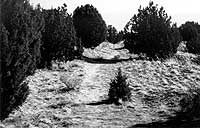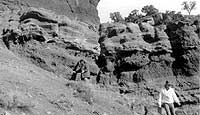|
Page
156
|
Massacre Rocks got its name because of an Indian attack on the Adams wagon train on the Oregon Trail on August 9 and 10, 1862. It was one of a series of Indian attacks on emigrants that summer along both the California Trail and this part of the Oregon Trail. These attacks were perpetrated mainly by the band of Northwestern Shoshoni led by Chief Pocatello. At Massacre Rocks, ten immigrants were killed either in the original attack or in skirmishes following it.
 |
 |
 |
|
(left) Culvert under the Oregon Short Line Railroad, Old American Falls townsite, (October, 1987). (center) Wagon ruts of the Oregon Trail just east of Massacre Rocks State Park, south of Interstate 84. Some accounts place the 1862 massacre just east of here (October, 1987). (right) Beds of fragmental volcanic debris blown out of the Massacre Volcanic center about 5 million years ago. Photo taken southeast of Interstate 86 at the Massacre Rocks exit (April, 1995) |
||
References
Hearst, J.M., 1990, Paleontology and depositional setting of the Duck Point local fauna (late Pleistocene: Rancholabrean) Power County, southeastern Idaho [M.S. thesis]: Pocatello, Idaho State University, 275 p.
Bright, R.C., 1982, Paleontology of the lacustrine member of the American Falls Lake Beds, southeastern Idaho, in Bonnichsen, Bill and Breckenridge, R.M., editors, Cenozoic Geology of Idaho: Idaho Bureau of Mines and Geology Bulletin 26, p. 597-614.
Hansen, Sam, and others, 1984, Hard times in Idaho between the great wars: Pocatello, Idaho, Idaho State University Press (reprinted from Rendezvous, Idaho State University Journal of Arts and Letters, volume XX, no. 1), 90 p.
Harder, E. B. and Harder, H. K. (compilers), 1982, Seventy-five years at Aberdeen: A History of the First Mennonite Church, Aberdeen, Idaho: First Mennonite Church, P. O. Box 246, Aberdeen, Idaho, 83210, 383 p.
Malde, H.E., 1968, The catastrophic late Pleistocene Bonneville flood in the Snake River Plain: U.S. Geological Survey Professional Paper 596, 52 p.
Malde, H.E., 1991, Quaternary geology and structural history of the Snake River Plain, Idaho and Oregon: in Morrison, R.B., editor, Boulder, Colorado, The Geological Society of America: Quaternary nonglacial geology: Conterminous U.S., The Geology of North America, volume K-2, p. 251-281.
Scott, W.E., Pierce, K.L., Bradbury, J.P., and Forester, R.M., 1982, Revised Quaternary stratigraphy and chronology in the American Falls area, southeastern Idaho: in Bonnichsen, Bill and Breckenridge, R.M., editors, Cenozoic Geology of Idaho: Idaho Bureau of Mines and Geology Bulletin 26, p. 581-595.
Ward, Laurie, 1982, Bannock Valley: Keith W. Watkins and Sons, Inc., Providence UT 84332, 322 p.